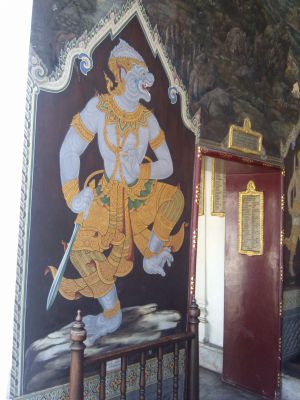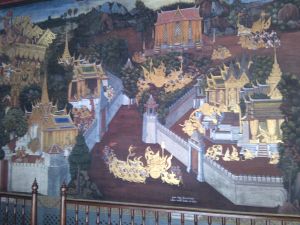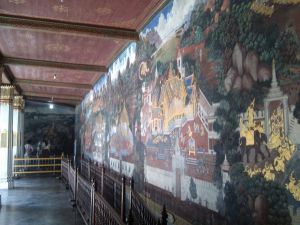Comics /
Spotlight /
Religion and Comics
Thailand's Ramayana Mural - The World's Longest Comic
By Hervé St-Louis
February 24, 2012 - 21:22
Here's a thought. The Ramayana mural found inside the Wat Phra Kaew temple within the Grand Palace in Bangkok, Thailand, is not only the world's longest painting, it is also the world's longest form of comic book art, better known as sequential art to comic book art historians. The mural, which is called, Ramakien is located on the outer walls of Wat Phra Kaew temple, also known in English as the Temple of the Emerald Buddah.
Ramakien is a Thai adaptation of the Ramayana, a popular and classic Hindu folk tale about Rama, the heir to the crown of Ayodhya, the eldest son of King Dasharathaand, the seventh avatar of the god Vishnu. Rama is forced into a 14 years exile by one his father’s wives. The story is epic. It describes the life of Rama before his exile, features his wife, his allies, his younger brothers and his opponents, including the demon-king Ravana, one of his arch enemies whom has to be defeated in war.
 |
Although of Hindu origin, Ramayana is popular throughout Asia and has been an important story to Buddhists. The Ramakien is the Thai version of this popular story adapted under the supervision of several Thai kings. Parts of the Ramakien have been destroyed and repainted. The Ramakien has been part of Thai's national culture for thousands of years, and its main characters are meant to depict the origins of ancient Thai kings.
Recognized as the world's longest painting, and revered in places such as Cambodia, the Ramakien murals feature 178 individual murals, or what comic book enthusiasts would call panels. Each panel or caption tells a part of the story of Ramakien. The murals are meant to be read from left to right.
Other world art artifacts have also been recognized as sequential art. Sequential art is a series of illustrations where each panel/caption/frame is part of an ensemble spread spatially. When viewed or read as a whole, the collection images forms one single body of work. What makes sequential art special is its focus on closure. Closure is the void between images that forces the viewer to fill in the gaps in the presentation/story.
The Ramakien murals certainly force viewers to jump from one image to the other, and forces them fill in gaps in the story in their mind.
The visual style of the Ramakien is based on three dimensional birds' eye views of scenes. All elements are juxtaposed on a wall. Viewers can see the scenes as if they were floating above, but also parallel to the characters and sets. The painted style is reminiscent of Thai painting of the 18th century, which is when most of the Ramakien was painted.
Ramakien is opened to the public and easily accessible through a visit of the Grand Palace in Bangkok. The Grand Palace is one of the most visited tourist attractions in Thailand. Once in Bangkok, the cost to visit the Grand Palace is minimal. Other attractions include the Jade Buddha statue, which cannot be photographed, and several buildings such as the throne temple used to perform the coronations of Thai kings. Guided tours are also available. For comic book fans who would like to view the entire Ramakien epic in an easy format, several, books containing every painting, sometimes with annotations, can be purchased in Bangkok or abroad.
The observation that the Ramakien in Thailand is sequential art, and therefore comic book art is a new claim, but one which I hope will quickly be accepted as official by the comic book art history community, just as the Trajan's Column in Rome has been accepted a few years ago.
Last Updated: January 17, 2025 - 08:20


